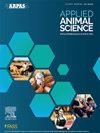Invited Review: The weaning transition in dairy calves—Why so traumatic?*
IF 1.5
Q3 AGRICULTURE, DAIRY & ANIMAL SCIENCE
引用次数: 0
Abstract
Purpose
The purpose of this review article was to identify physiological and management factors that affect the weaning transition in dairy calves, which can be a dif- ficult time for calves.
Sources
Peer-reviewed journal articles were used to compile the review.
Synthesis
Weaning is often a period of stress and lost performance for calves, in many cases resulting in respira- tory disease or diarrhea caused by coccidiosis or acidosis. Physiological factors contribute to the difficulty, including the expanding gut fill, allometric growth of the reticuloru- men and gastrointestinal tract, and development of the ruminal epithelium. Stabilizing ruminal pH above 6.0 so that fiber fermentation can proceed is a major challenge for calves. Management practices should aim to maximize starter intake while avoiding ruminal acidosis. Providing a high-quality calf starter is extremely important, including appropriate ingredient and chemical composition as well as physical form. Calves should not be weaned until they are consuming an adequate amount of starter to allow the discontinuation of milk intake and should be weaned gradually rather than abruptly. Although small amounts of forage before and after weaning may be useful in calves fed pelleted or ground starters and not bedded on straw, calves should not have free access to alfalfa hay. Water ac- cess is critical because the rumen needs water to support the developing microbial ecosystem. Stressful management tasks such as dehorning or vaccination should not be per- formed at the same time as weaning. Ruminal acidosis is likely more common than has been recognized and causes decreased intake, decreased growth, and diarrhea, espe- cially in calves soon after weaning.
Conclusions and Applications
The weaning tran- sition is a period of stress for calves. Managing starter quality, time and rate of weaning, forage and water avail- ability, concurrent stressors, and acidosis can help avoid difficult weaning and improve the welfare of young calves without losing performance.
特邀评论:奶牛犊牛的断奶过渡期——为什么如此痛苦?*
目的本综述的目的是确定影响犊牛断奶过渡的生理和管理因素,这对犊牛来说可能是一个困难的时期。资料来源本综述采用同行评议的期刊文章。断奶对小牛来说通常是一段压力和性能下降的时期,在许多情况下会导致呼吸道疾病或由球虫病或酸中毒引起的腹泻。生理因素导致了这一困难,包括肠道填充的扩大,网状和胃肠道的异速生长,以及瘤胃上皮的发育。将瘤胃pH稳定在6.0以上,使纤维发酵能够进行,是犊牛面临的主要挑战。管理措施应以最大限度地提高发酵剂摄入量为目标,同时避免瘤胃酸中毒。提供高质量的犊牛发酵剂是非常重要的,包括适当的成分和化学成分以及物理形式。小牛不应该断奶,直到他们消耗了足够数量的发酵剂,允许停止牛奶的摄入,应该逐渐断奶,而不是突然。虽然在断奶前后少量的草料可能对饲喂颗粒状或磨碎的犊牛有用,但犊牛不应该随意接触苜蓿干草。水处理是至关重要的,因为瘤胃需要水来支持微生物生态系统的发展。压力管理任务,如脱角或接种疫苗不应在断奶的同时进行。瘤胃酸中毒可能比人们认识到的更常见,它会导致摄取量减少、生长减慢和腹泻,尤其是在断奶后不久的犊牛中。结论与应用断奶过渡期是犊牛的应激期。管理发酵剂质量、断奶时间和断奶速度、饲料和水分利用率、并发应激源和酸中毒有助于避免断奶困难,在不影响犊牛生产性能的情况下提高犊牛的福利。
本文章由计算机程序翻译,如有差异,请以英文原文为准。
求助全文
约1分钟内获得全文
求助全文

 求助内容:
求助内容: 应助结果提醒方式:
应助结果提醒方式:


